Octber 13, 2007
Plant of the Week
by
David Rodriguez
 October is the month of stinking delights and except for the onion, Garlic, Allium sativum L., is probably the most widely used “stinker” of the cultivated Alliums. With Halloween just around the corner, garlic is not just used to scare off Vampires, but as a condiment often used as a flavoring and seasoning in prepared food products such as soups, sausages, and pickles. It is also frequently used in salads and other home cooking. Garlic salt is made from pulverized, dehydrated garlic cloves. In some countries, the green tops are used as well as the bulbs.
October is the month of stinking delights and except for the onion, Garlic, Allium sativum L., is probably the most widely used “stinker” of the cultivated Alliums. With Halloween just around the corner, garlic is not just used to scare off Vampires, but as a condiment often used as a flavoring and seasoning in prepared food products such as soups, sausages, and pickles. It is also frequently used in salads and other home cooking. Garlic salt is made from pulverized, dehydrated garlic cloves. In some countries, the green tops are used as well as the bulbs.
Garlic does not produce true seed but is propagated by planting cloves, which are the small bulblets, or segments, making up the whole garlic bulb (as the above image). In Texas, garlic is a perennial plant. Garlic can be planted in the late fall. It is extremely frost hardy, and if planted in October, may have tops showing above the soil and be well rooted by November. The crop will mature in June. The growing period before bulbing may be too short for satisfactory yields if planted in the spring.
The cloves, when used for propagation, are commonly termed ‘seed’ or ‘sets.’ Most seed companies sell garlic cloves under the name of garlic sets, and make no mention of separate varieties. In Texas, seed firms may sell two distinct types of garlic varieties: (1) Creole like Early Louisiana and White Mexican, and (2) Italian like Late or Pink. Creole is earlier than Italian, but does not store as well.
Each large garlic bulb contains about ten cloves. All the cloves are planted except the long, slender ones in the center of the bulb and those that are less than one gram in weight. Bulbs that have side growths should be discarded. Garlic yields generally increase as the mother bulbs increase in size from small to large. This appears to be an effect of clove size, since large mother bulbs usually yield larger cloves.
Garlic is usually planted three-to-six inches apart in rows 18 to 24 inches apart. Higher yields can be obtained with cloves planted as close as two-inches and in rows that are 12 inches apart. But, as the density of the planting increases, the size of the individual bulb decreases. The depth of planting is one-to-two inches, depending on soil conditions. The cloves must not be so deep that the soil will interfere with the swelling of the bulbs, nor so shallow that rain will wash them out. The vertical placement of cloves by hand into planting furrows will insure production of straight-necked, high-yielding plants.
Soil that is suitable for onions will generally produce good garlic. Soils that have high organic matter content are preferable to other types, since they hold moisture well and do not pack, preventing proper bulb expansion. Heavy soils tend to prevent the uniform expansion of the bulb resulting in irregular shapes and rough surfaces, which are objectionable.
Garlic is shallow rooted, and deep cultivation should be avoided as the damage to the roots will retard growth and reduce yields. Weed removal in the plant rows should be done by hand-hoeing. Feed every 14-21 days with a high slow release nitrogen fertilizer, such as a 19-5-9 analysis, at a rate of one cup per ten linear row feet.
Most garlic roots grow in the upper two feet of soil and at each irrigation, the soil should be soaked to this depth, throughout the growing season to ensure that the roots receive a continuous supply of moisture. As the crop approaches maturity, watering should cease, so that the soil will dry for harvesting. Continued irrigation will cause rotting of the root and bulb scales.
When the tops become partly dry and bend to the ground, garlic is usually ready for harvest. The bulbs are usually pulled and gathered into windrows. The tops are placed uppermost in the windrow to protect the bulbs from the sun, and the garlic is left in the garden for a week or more to dry (or cure) thoroughly. Curing can also be accomplished in a well-ventilated shed. The bulbs must be thoroughly dried before being stored.
When properly cured, garlic stores well under a wide range of temperatures. Garlic production requires a long-term commitment. Since this crop is long-term, plant it in areas that can remain undisturbed when spring cultivation is necessary. Of course, at least 6 hours of sunlight is required daily.
Well here we you go, a little bit about this great “stinker” garlic.
Remember, Learn and Have Fun!
David Rodriguez is County Extension Agent-Horticulture, Bexar County. For more information, call the Master Gardener ‘Hotline’ at (210) 467-6575 or visit our County Extension website at http://bexar-tx.tamu.edu, click under Horticulture and Gardening.